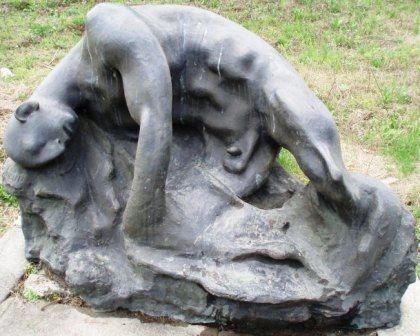Full Name Matija Vukovic Name Matija Vukovic | Nationality Serbian | |
 | ||
Born 26 July 1925 Platicevo, Kingdom of Yugoslavia Notable work Woman with Dead Child, Wounded Man, Bison, Perun, As, Njegos | ||
Matija vukovi 1925 1985
Matija Vuković (Platičevo, 26 July 1925 – Belgrade, 21 June 1985) was a Serbian sculptor.
Contents
- Matija vukovi 1925 1985
- BASKET 4 KIDS Matija Vukovi KK Mega Basket Basket4Kids Niki
- Biography
- Style
- Exhibitions solo selection
- Works selection
- Recognition
- References
BASKET 4 KIDS | Matija Vuković KK Mega Basket | Basket4Kids Nikšić
Biography
Matija Vuković was born into a poor farming family in Platičevo, on 26 July 1925. From his native village, near Ruma, after primary school, in 1937, the boy and his mother move to Belgrade, near the studios of the famous sculptor Toma Rosandić. He was fascinated by the Maestros "huge figures", then Mestrović's sculptures, and then in one of the books he got as a present book, he saw Michelangelo's Moses. All this will paved his way into the art. Vuković attended private art school of Mladen Josić in 1941 – 1942.
Immediately after the liberation of the Belgrade, in October 1944, Matija Vuković was mobilized and sent to the Syrmian Front, where, during a charge, he was wounded in the hand. He returned home as a disabled veteran and – devoted himself entirely to sculpture. Having successfully met the entrance exam, he studied at the Academy of Fine Arts and was treated in parallel. He learned from the top Yugoslav sculptor Tom Rosandić, and then attended the class of the professor Sreten Stojanović. He starts to exhibit in group exhibitions in 1949. Vuković graduated from the Academy of Fine Arts in 1952. In 1954. during special classes of prof. Ilija Kolarević he sculpts "Wounded Man" (1952–1953), which revealed his original creative style. First solo exhibition Matija Vuković had in 1954. at the Art Gallery at Kalemegdan. He has participated in numerous group exhibitions at home and abroad.
His life was hard and he was for the most part misunderstood by his surroundings and critics. He died in Belgrade on 21 June 1985, after long disease.
Style
Matija Vuković appeared at the time of break from the aesthetics of socialist realism, in the early 1950s, with works that are significantly different from academic form. His basic forms, that retain the illusion of "realism" and a distant figurative narrative, are shaped by powerful, cruel, deformed masses that have a vibrant creative expression of the author, which became his plastic sign, and at the same time, a unique figure in the Yugoslav sculpture of the late 20th century. With his work Matija Vuković pointed to yet another possibility of modernizing new form, which will be free to develop towards plastic conceived by the author. Matija Vuković has built one of the most authentic works of contemporary Serbian and Yugoslav sculpture after 1950.
Exhibitions (solo, selection)
Works (selection)
Recognition
A street in Belgrade is named after of sculptor Matija Vuković.
